This week in the BMJ
Volume 324, Number 7345, Issue of 4 May 2002Standard surgery for urinary symptoms leaves men with less sexual dysfunction
Behavioural sleep intervention improves infants' sleep and mothers' mood
General public fails to recognise early symptoms of stroke
In-hospital mortality data are misleading
The number of children drowning in garden ponds is increasing
Nurse specialists in Parkinson's disease preserve patients' wellbeing
"Conventional" CT scanning superseded by spiral scanning
Bone marrow transplantation for breast cancer is not effective
NICE is wrong not to recommend laparoscopic hernia repair
Standard surgery for urinary symptoms leaves men with less sexual dysfunction
In men who need treatment for lower urinary tract symptoms, standard
surgery (transurethral resection of the prostate) results in lower
levels of sexual dysfunction and less pain or discomfort on ejaculation
compared with non-contact laser therapy or conservative management
(watchful waiting). In a multicentre randomised controlled trial of
various treatments for urinary tract symptoms Brookes and colleagues
(p 1059) found that erectile function was significantly improved after
standard surgery and pain on ejaculation was significantly less. Older
men who need treatment for urinary symptoms and want to retain or
improve sexual function may want to consider standard surgery rather
than non-contact laser therapy.
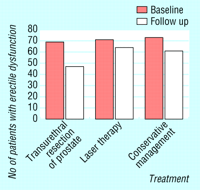
Behavioural sleep intervention improves infants' sleep and mothers' mood
In a large community sample a brief behavioural sleep intervention
based on teaching mothers how to implement controlled crying led to a
20% reduction in infants' sleep problems compared with mothers who
did not receive the intervention. Hiscock and Wake (p 1062) also found
that symptoms of maternal depression were significantly reduced. The
intervention was highly acceptable to mothers, involved minimal family
disruption, and reduced the need for mothers to seek other help for
their infants' sleep.
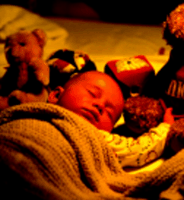
(Credit: GEOFF TOMKINSON/SPL)
General public fails to recognise early symptoms of stroke
The general public does not find it easy to recognise the early signs
of stroke, and people want simple, understandable educational materials
about stroke. This is the finding of a qualitative study by Yoon and
Byles (p 1065) in which 35 participants took part in discussion groups
and answered questionnaires about stroke. For maximum effect,
thrombolytic agents must be given soon after acute ischaemic stroke.
Unless people know they are or might be having a stroke, that
opportunity will be missed.
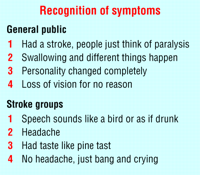
In-hospital mortality data are misleading
The percentage of in-hospital deaths within 30 days of an admission for
surgery has fallen from 79% in 1963-74 to 61% in 1987-98. This
reflects decreases in length of hospital stays and an increase in
transfers of acutely ill patients between hospitals for specialist care. Goldacre and colleagues (p 1069) argue that in-hospital mortality is now an incomplete measure of mortality and records should
be linked to data from death certificates.
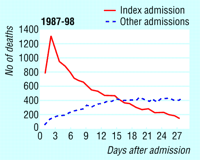
The number of children drowning in garden ponds is increasing
The number of children drowning in rivers, lakes, and canals in Britain
fell between 1988 and 1999. However, the number drowning in pools
abroad, and in garden ponds, rose significantly. Sibert and colleagues
(p 1070) state that safety organisations and holiday companies need to
improve the safety of children abroad, while garden ponds should be
covered or fenced. Detailed data on deaths by drowning also need to be
collected routinely.
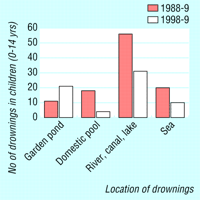
Nurse specialists in Parkinson's disease preserve patients' wellbeing
Most patients with Parkinson's disease have no regular contact
with a consultant specialist. Contact with specialist nurses has been
thought to be valuable as it increases the provision of information. A
two year randomised controlled study by Jarman and colleagues (p 1072)
looked at effects on patients and found that the provision of community
based nurse specialists did not alter the progression of the condition
but did improve patients' sense of wellbeing, with no increase to
healthcare costs.
"Conventional" CT scanning superseded by spiral scanning
The role of "conventional" computed tomography is in decline and
has been superseded by spiral scanning, which is faster and less
sensitive to artefacts such as movement or breathing. Garvey and Hanlon
(p 1077) explain the different types of scanners and their uses in
this week's clinical review. Multislice scanning is better than spiral
scanning but has important cost and storage implications. Concerns
regarding the x ray dose of scanners may relegate computed
tomography to a secondary role as availability of magnetic resonance
imaging increases.
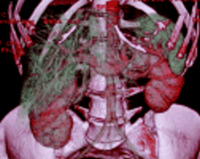
Bone marrow transplantation for breast cancer is not effective
Intermediate outcomes and inadequate controls made preliminary evidence
of the benefits of bone marrow transplantation for breast cancer
misleading. Statements by doctors in the medical literature and the
general press in the United States reinforced the presumption of
benefit, as did the decision of government bodies to mandate insurance
coverage. The findings of major randomised trials did not support the
use of the treatment. Welch and Mogielnicki (p 1088) describe the
American experience, where for more than 10 years the major dilemma was
who should pay for bone marrow transplantation, not whether it
worked or not. They say it provides lessons relevant to complex cancer
treatments currently in development.
NICE is wrong not to recommend laparoscopic hernia repair
NICE's reluctance to recommend laparoscopic repair of hernias is based
mainly on economic considerations, some of which are inaccurate,
according to Roger Motson, professor of surgery (p 1092). Inguinal
herniorrhaphy is one of the commonest operations in Britain. It is less
painful than traditional repair and allows the patient to return to
work more quickly. The true costs of laparoscopic repair are lower than
those of open repair, particularly when it allows detection and
simultaneous repair of an undiagnosed contralateral hernia. Motson
concludes that surgeons are under-represented on NICE's appraisal panel.